Of Lesser-Known Stripes Among Tangled Roots
First published in Sanctuary Asia,
Vol. 43
No. 8,
August 2023
By Tiasa Adhya and Justin Jones
Not exactly stripes, more like blotches. Not exactly duck-like feet, but its paws are indeed partially webbed. Interestingly, the cat’s call, sometimes does sound like the quack of a duck, albeit with a slightly heavier and rougher accent! Other times it brings to mind the bark of an adolescent dog. Its double-layered fur acts like a ‘raincoat’ of sorts, and protects the skin underneath from getting totally soaked. It thrives in a world of water and mud, a proposition most cats despise. Such is the fishing cat – an ecological oddity in the charismatic cat family.
A Rich, Wet Abode
When early human-like beings were evolving to become Homo sapiens, the ancestors of modern cats were also making evolutionary strides. In fact, all the cats we see in our world today evolved into distinct species – about 40, within an incredibly brief timeframe, comparable to the blink of an eye for the universe. That was possibly why we see fewer prominent differences, leading them to look and often even behave like each other. Next time you look at a domestic cat, just compare its features and many of its habits to that of the tiger! The aversion to water is a prominent feature in the small cat family, with two exceptions – the flat-headed cat Prionailurus planiceps and the fishing cat Prionailurus viverrinus. The former is endemic to Southeast Asia, the latter is found in South and Southeast Asia. Incidentally fishing cats are the size of the average street dog and, yes, they are adept swimmers.
Apart from riverine floodplains and deltas, what one unfailingly observes in the fishing cat’s global distribution is the boom in the availability of suitable living conditions around the lower Gangetic floodplain. The incredibly well-adapted felines are found across the entire 10,000 sq. km. Sundarban mangrove delta between India and Bangladesh. And why not? Imagine the might of the Ganga uniting with the strength of the Brahmaputra, bursting forth into endless symphonies of mud and water – from streams and tributaries to ox-bow lakes and from marshes to wet meadows, before forming the wondrous swampland that is the Sundarban, where fresh water finally meets its salty counterpart in the Bay of Bengal. This rich, wet landscape is a global, ecological heritage shared by humans and non-humans alike on either side of the international border.
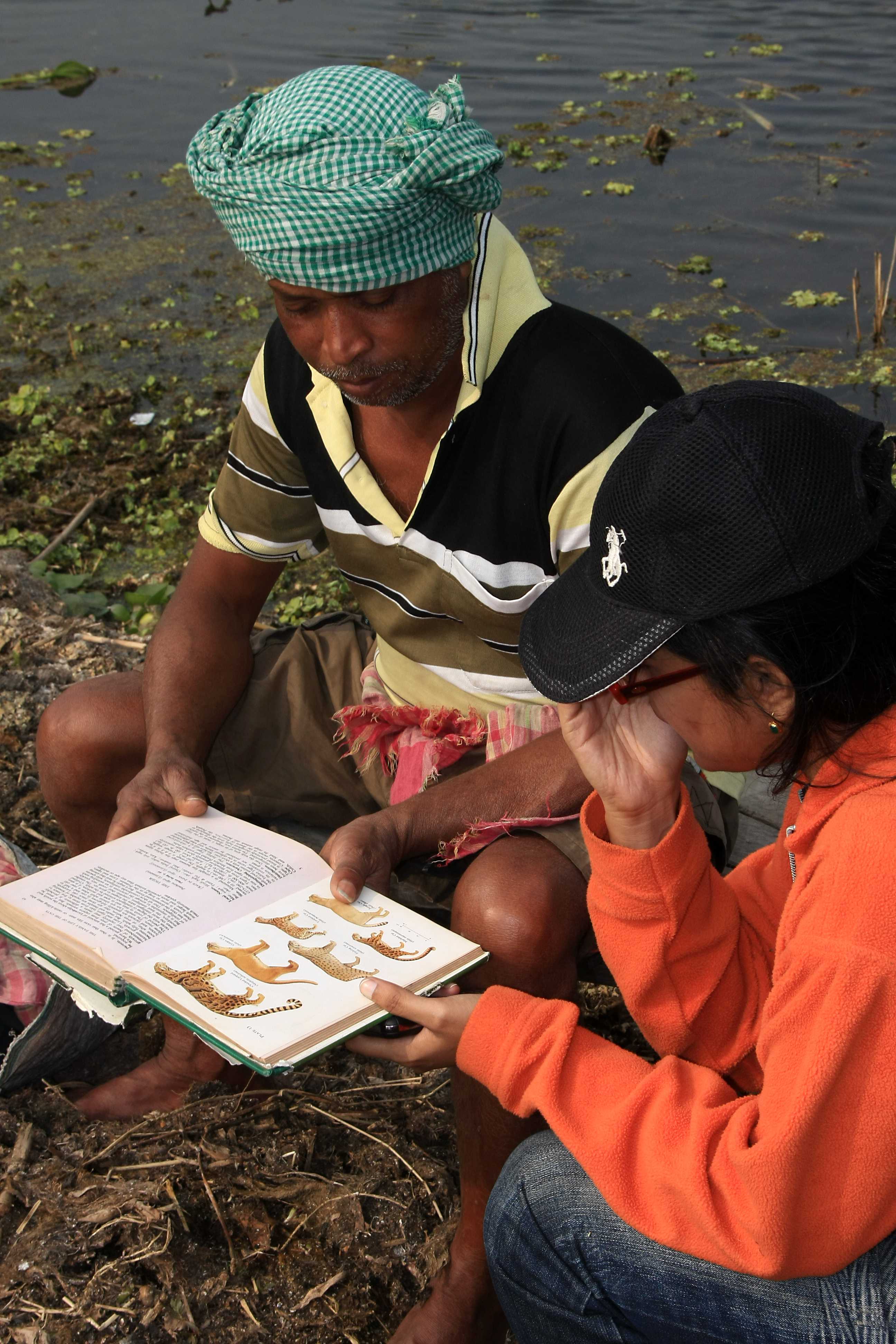
Tiasa conducting an interview survey on the Hooghly. With its webbed, hook-like claws, double-coated fur, rudder-like tail and fish dependent diet, the species is perfectly adapted to life in wetland habitats. Photo: Partha Dey.
The fishing cat, intricately linked with these wetlands, is one key face of the landscape. This nocturnal feline is a hypercarnivore – an absolute meat-eater, as are all members of the cat family. The fishing cat’s claws protrude slightly even when retracted, enabling it to catch prey underwater. Wetlands are known to be the richest ecosystems on the planet, providing habitats to a diversity of life forms, unlike any other. In a sense, wetlands are like five-star buffets for predators, offering an assortment of delicious food items. Apart from fish, their prey of choice, fishing cats are known to have an eclectic diet and can take molluscs, crabs, frogs, reptiles, birds and small mammals such as rodents. This predator-prey interaction ties the fishing cat, along with several other species into their chosen food web. Put another way, if a wetland has an abundance of fishing cats, it indicates that the web of life in the system is strong enough to sustain that feline population.
Strength of Numbers and Technology
So how is the Sundarban ecosystem faring? One way to assess that would be to establish that the wetland has a good number of fishing cats. We follow the same logic to differentiate between fishing cats as we now identify tigers. Every fishing cat has a unique coat pattern! The four to six stripes that start from its forehead and move down its neck start breaking into blotches. It is easy for the trained eye to pick up the differences in the patterns at the point where the stripes break into blotches. Sometimes, unique standalone symbols are created – a slanted N or a broad tick mark. Apart from this, the general arrangement of blotches on the camouflaging grey-brown body, the cheek marks, the half-formed stripes on the legs and the tail are all areas where the uniqueness of patterns are revealed. In essence, clear photographs of the left and right flanks of fishing cats can positively identify and help with enumeration in wetlands.
Using this technique, India’s first systematic fishing cat population survey was conducted in two phases – from March to May of 2021 and 2022 in Odisha’s Chilika, Asia’s largest brackish water lagoon, and India’s first Ramsar site. A similar exercise was also attempted in the Bhitarkanika National Park jointly by The Fishing Cat Project and the Odisha Biodiversity Board, which yielded partial success on account of logistical constraints. Compared to Chilika’s marshlands and fragmented Pandanus swamps, mangrove ecosystems are more challenging for the fishing cat. The species has to live with not only two high tides that inundates sizeable portions of its living space per day but also deal with the eccentricity of the tides under the lunar spells of new moons and full moons, each fortnight. Add monsoon to the equation and we start seeing how harsh and strict life can be. What could be their densities in such dynamic ecosystems? There was only one way to to solve this conundrum – by taking photographs within a robust scientific framework.
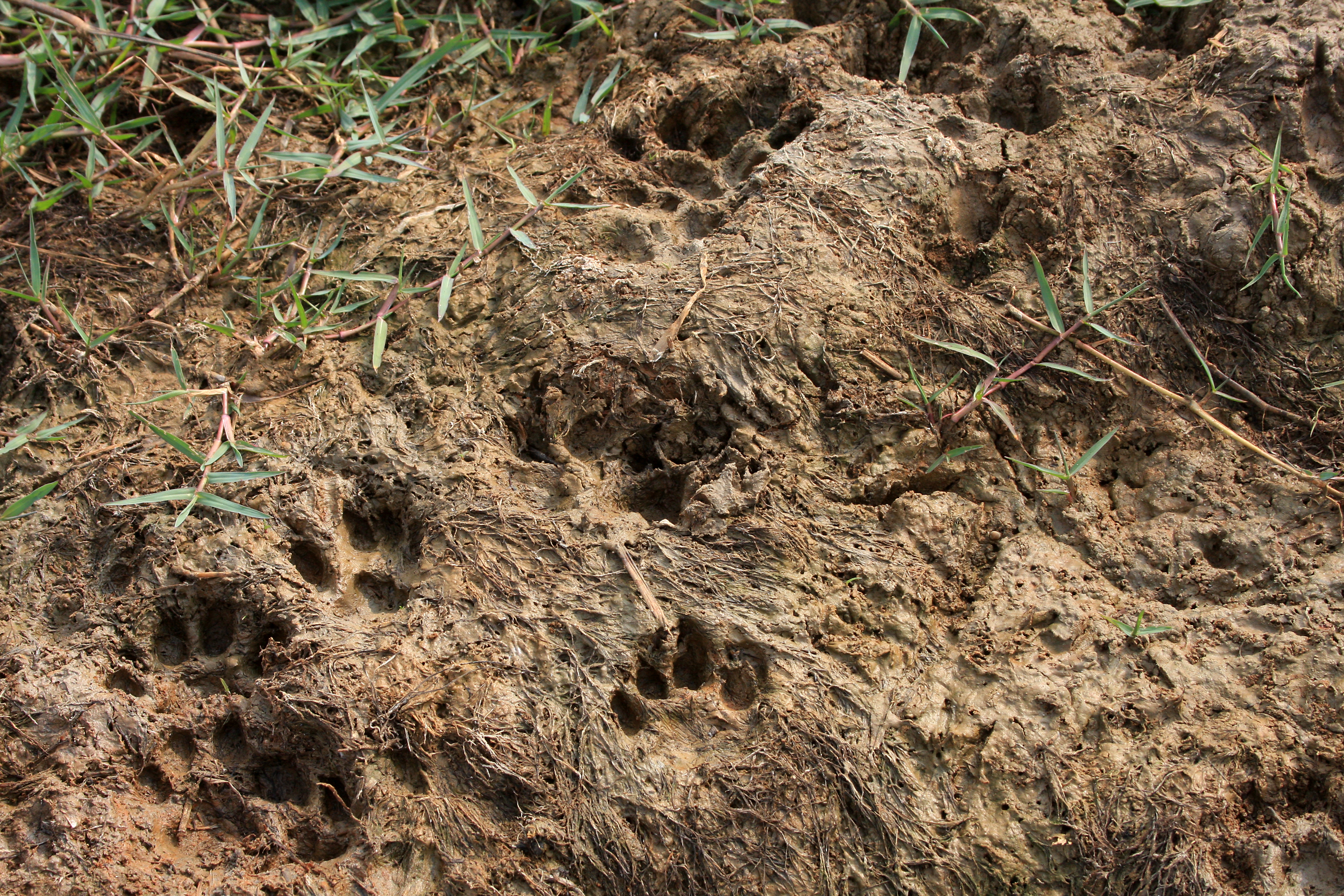 The author Tiasa Adhya’s first introduction to the fishing cat was seeing its pugmarks in the Sundarban Biosphere Reserve during a tiger census. Signs such as pugmarks and scats provide valuble preliminary information about species presence in an area that can be confirmed using camera traps. Photo: Partha Dey.
The author Tiasa Adhya’s first introduction to the fishing cat was seeing its pugmarks in the Sundarban Biosphere Reserve during a tiger census. Signs such as pugmarks and scats provide valuble preliminary information about species presence in an area that can be confirmed using camera traps. Photo: Partha Dey.
Camera traps are used to get such photographs. Such scientific technology enables us to obtain thrilling insights into the natural history of the non-human world in never before imagined ways. Three decades ago, however, camera trapping was a cumbersome affair. The movement and route of the wild animal had to be anticipated and based on this intuition, the camera and accompanying flashlight were positioned. Wired to this set-up was a sensor that had to be hidden underneath the soil in the animal’s preferred path. The unsuspecting animal would step on the sensor, triggering the flash and the camera simultaneously. This is how the first camera trapped image of a fishing cat was captured from the Sundarban way back in the 80s – a lovely female walking up to pick off a fish hanging from a strategicallyplaced bait.
Where is it Found?
One end of the fishing cat’s global distribution lies in the Indus delta and the floodplains of Pakistan, and at the other end lies the Mekong delta and its floodplains spanning both Cambodia and Vietnam. Prionailurus viverrinus was also historically found on the islands of Java and Sri Lanka. In India, the cat is found in the floodplains of the Ganga-Brahmaputra basin spanning several states, and in the lower reaches of the floodplains and deltas created by east-flowing, peninsular rivers like the Mahanadi, Godavari and Krishna. Protected Areas that are home to the fishing cat in India include the Keoladeo National Park, Corbett National Park, Dudhwa Tiger Reserve, Katarniaghat Wildlife Sanctuary, Kaziranga National Park, Sundarban Biosphere Reserve, Bhitarkanika Wildlife Sanctuary, Coringa Wildlife Sanctuary, and Krishna Wildlife Sanctuary.
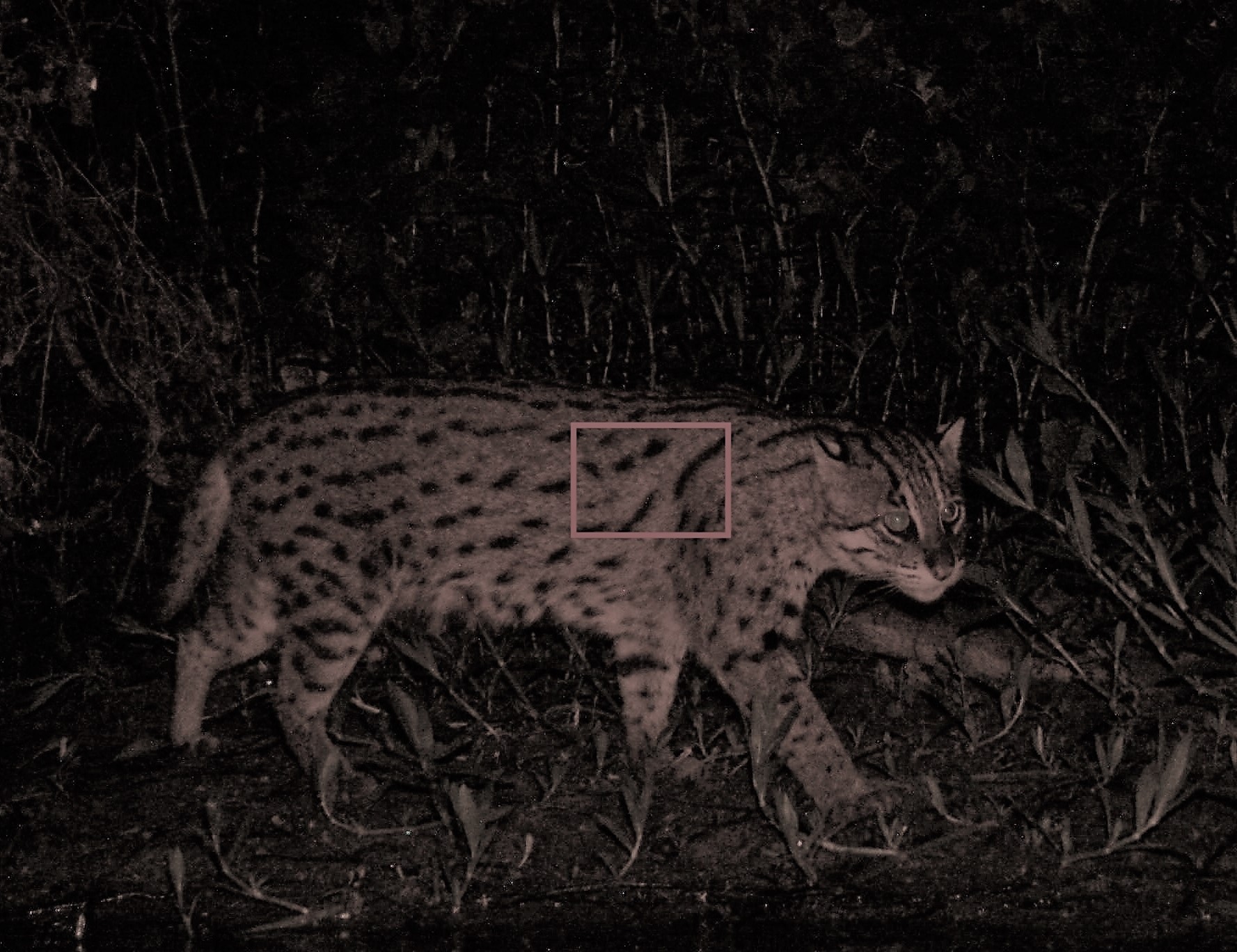
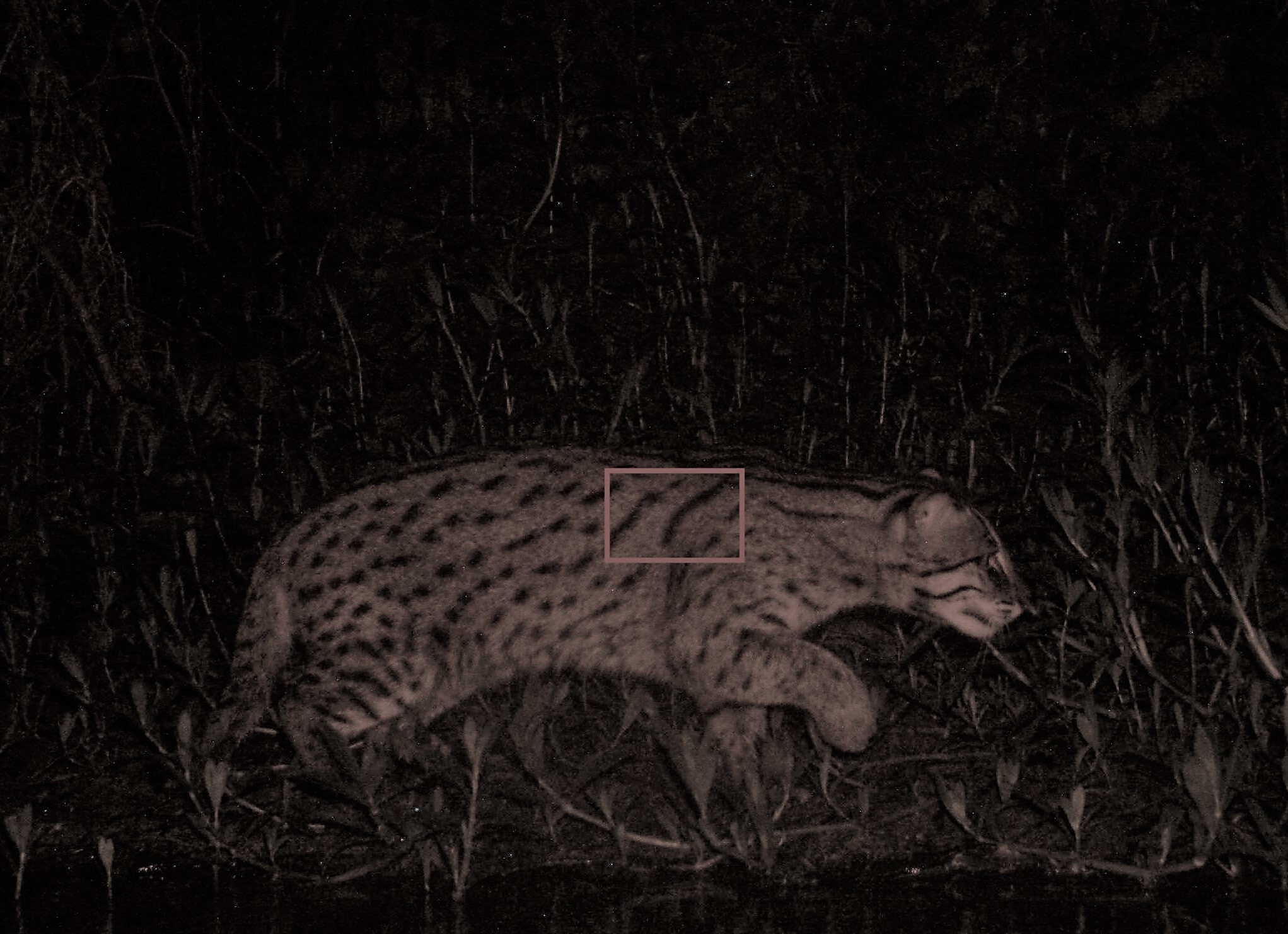 Camera trap images of the fishing cat’s side flanks show how each individual’s coat pattern differs. Photo: TIasa Adhya.
Camera trap images of the fishing cat’s side flanks show how each individual’s coat pattern differs. Photo: TIasa Adhya.
Life is (technology-wise) easier now, but field expertise and experience remain non-negotiable skills. Camera traps have become sophisticated, with motion-detecting sensors that offer high-resolution images. But nothing works if the cat’s path is not perfectly tracked. The fishing cat’s pugmarks, are most often found near the water’s edge. But, as we know, life in the Sundarban is not easy! Not for its wild lifeforms, nor for scientists working to document them. Afterall, the ebb and flow of tides, twice a day, creates a complex paradox – instability and certainty at the same. For us, the latter consequence matters – for the waters will engulf the camera traps most certainly twice a day if they are placed by the river banks. Paths must therefore be located on somewhat higher ground so as not to be inundated, and where the camera traps would be safer. However, it is comparatively difficult to find pugmarks on higher grounds that have drier and harder substrates. It is easier to find other evidences here: scats – important markers left by the cats at visually prominent places. That is how they delineate their territories, guard promising food locations and leave signals for potential mates. One could also, with luck, pick up pheromone scents at scat deposition locations. Only after considering such permutations and combinations do experts choose where to set camera traps. On such routes frequented by the subject, a pair of camera traps will be placed on both sides to perfectly capture both flanks of the fishing cat.
Useful By-catch
A full-fledged scientific survey spanning the nooks and corners of the Sundarban to place camera traps and estimate the fishing cat population is not impossible, but is without doubt a difficult proposition, both logistically and financially. To begin with, a human walking through the dense mangrove forest puts herself, or himself, at risk from unwelcome encounters with Sundarban’s tigers. No matter how big your research group might be, it would still necessitate moving in a single file, not knowing if a predator lurks behind the thick foliage and tangled roots. Of course, a gunman accompanies the survey party – but more often than not that merely amounts to a courage boost! Any way you look at it, it’s a daunting task, not for the fainthearted. And then you have logistics to take into account – a huge workforce, the hiring of powerful-engine boats to deploy multiple groups deep into the labyrinthine creeks each day, and, finding the necessary funding for a cat out-competed by the charismatic tiger. But here is the good news – this ambitious dream saw the light of the day thanks to the foresight and determination of the West Bengal Forest Department. They found resonance in the idea of studying the life of West Bengal’s state animal.
If the tiger-occupied forests in India could be thus monitored, why not the fishing cats of the Sundarban too? In any event, periodically, camera traps were being set up across the Sundarban to estimate and monitor Panthera tigris’ populations! Each tiger possesses a unique stripe pattern, as does the fishing cat, and this then became a prestige project for West Bengal. An additional bonus was the fact that all wild animals that used the same trails were automatically also camera trapped. And these ‘by-catch’ images are now helping the authorities get a better idea of which other animals share the royal Bengal tiger’s home. Following this logic, we hope to get a realistic idea of the population size of fishing cats occurring in the world’s biggest mangrove swamp. This, scientists and biodiversity experts agree, represents a huge contribution to not only science, but conservation per se.
A First in the Wild
The first camera trapped image of a fishing cat was captured from the Sundarban way back in the 80s by Kushal Mookherjee, one of the best natural historians in the country. He was best known for his depth of knowledge on birds and often led the waterfowl census in Bengal. He was also keenly interested in smaller, lesser known mammals. He had been part of surveys on the pygmy hog and the hispid hare, all of which were ground-breaking in India. His interest in fishing cats led him to try and camera trap them for the first time in the wild, in the Sundarban.
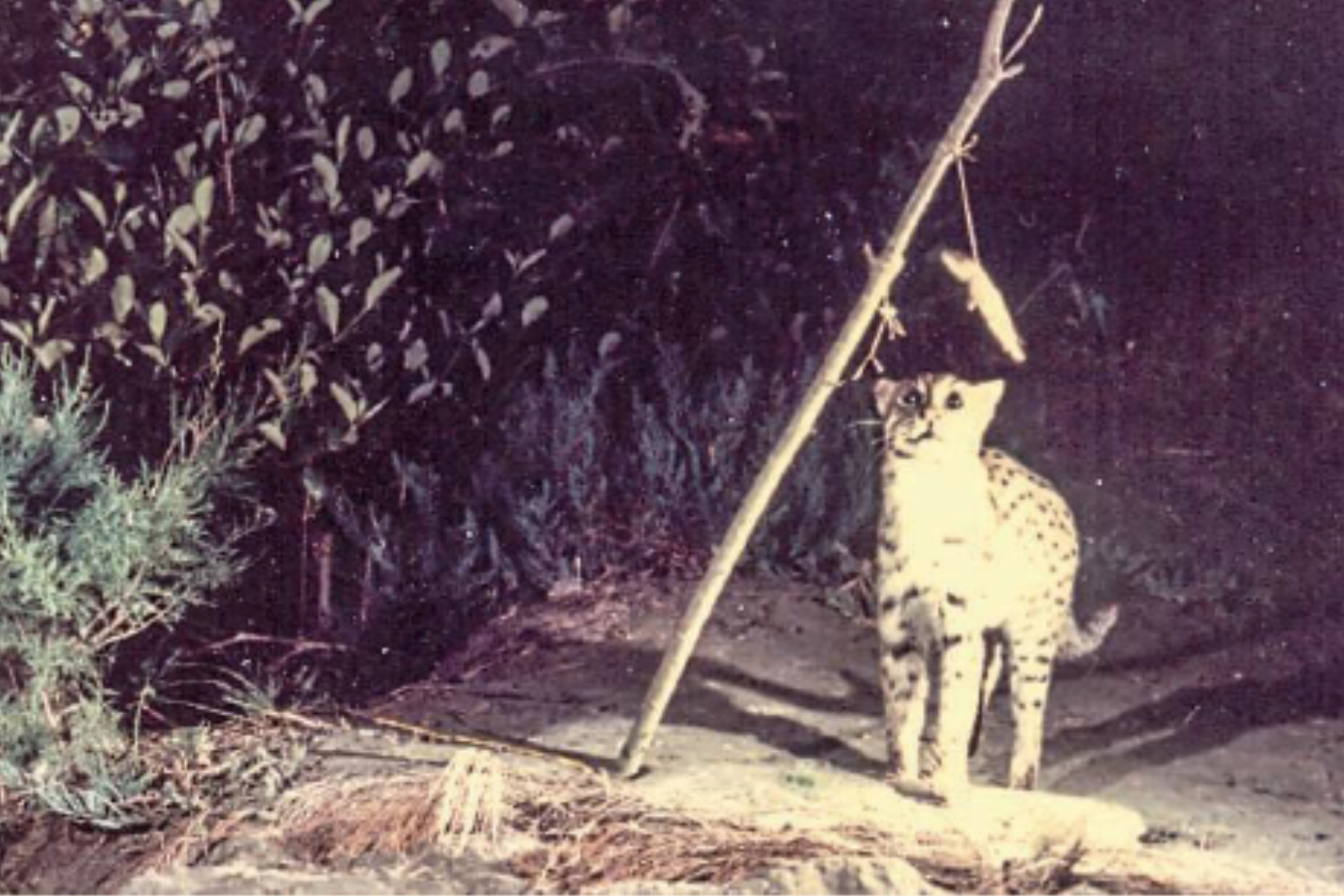 Kushal Mookherjee orchestrated the first fishing cat camera trap image in the wild, leading to this ‘historic’ image of the feline trying to grab the fish hanging from a strategically-placed bait. Photo: Kushal Mookherjee.
Kushal Mookherjee orchestrated the first fishing cat camera trap image in the wild, leading to this ‘historic’ image of the feline trying to grab the fish hanging from a strategically-placed bait. Photo: Kushal Mookherjee.
The Pioneering Watershed Survey
The winter of 2022 brought a slight deviation from the customary annual survey that once focused solely on monitoring tigers – to one that also began to survey Sundarban’s fishing cat populations. As always, maps of the four ranges of the Sundarban mangrove forest – National Park East, National Park West, Sundarban Wildlife Sanctuary and the Basirhat range – were overlaid with two square kilometre grids. A total of 573 camera trap pairs were strategically placed over an area of approximately 2,585 sq. km. But the photographs from these camera traps would now be scanned for not one but two sets of data – the tiger and the fishing cat.
Not surprisingly, while disembarking from our boats to place the camera traps on the many islands of Sundarban, we observed tiger trails overlapping fishing cat trails. These trails would lead us to the interior of the islands, which surprisingly were much more open and barren compared to the outside near-impenetrable wall of mangroves and tangled roots. Consequently, deeper into the islands, it was easier to locate scats of both the tigers and fishing cats. Both seemed to choose the higher, drier and open interiors of the islands to defecate and assert their domination of territories. Before alighting, it was customary to burst firecrackers to scare off tigers. But from the moment anyone got down from the safety of the boat and entered the tigers’ domain, in search of suitable locations for camera traps (which would be tied to trees on either side of a predicted route) every action involved heightened tension and alertness. We were instructed by our ever-vigilant gunman not to expose our backs to the jungle, or turn our gaze away from the dense vegetation. In the event, our camera traps were swiftly deployed and data on ecological variables noted down as fast as possible. As soon as the bait (smelly meat morsels), was laid out in front of the traps, we beat a hasty retreat back to the safety of the boat. The pungent smell would undoubtedly be a strong attraction for carnivores and when sifting through the camera trap photographs later, we discovered that carnivores would sometimes be drawn to the smell within five minutes of our departure. On one such occasion, we had to fire into the air to actually scare away a tiger we spotted.
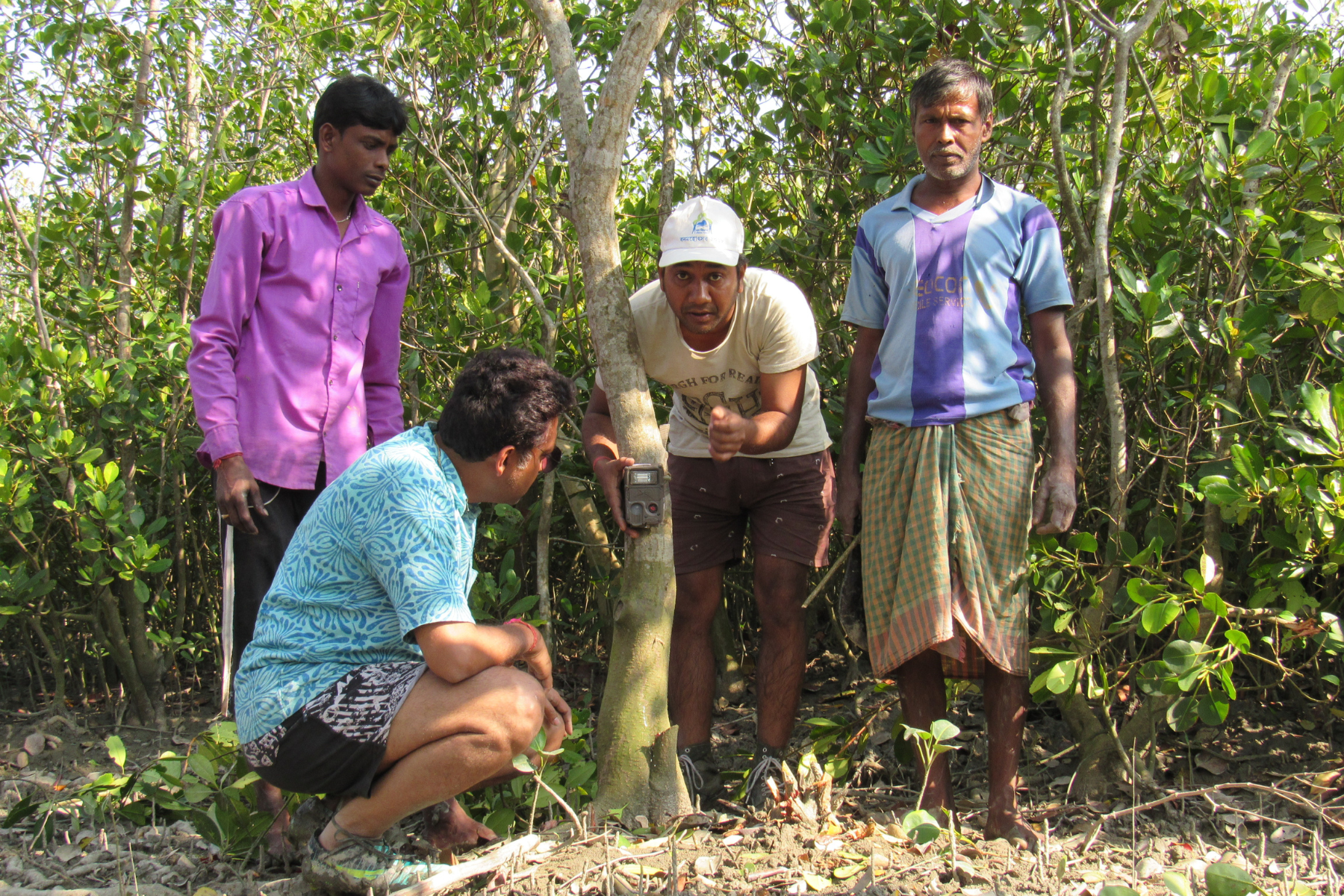
Three decades ago camera trapping was a cumbersome affair. The movement and route of the wild animal had to be anticipated and based on this intuition, the camera was positioned. Camera traps have now become very sophisticated, with motion-detecting sensors that offer highresolution images. Photo: Divyajyoti Ganguly.
The ubiquitous pneumatophores – mangrove roots that shoot up out of the ground to access air, can be unkind to bare feet, in a hurry. One is bound to carry tell-tale reminders on the soles of their feet – how ill-equipped, and vulnerable, humans are to wander into such untamed wildernesses, where any creature that can be overpowered must assume it flirts with danger. In some parts of the terrain, clothed in deep, soft, wet and very sticky mud, we learned from experience that highboots, sandals and slippers are impossible to use. The mud and water refuse to let go once it has engulfed a human up to the knees, sometimes the waist! So, when you finally fight successfully against the muddy gravitational pull, and extricate your lower body and legs back out, the sacrifice of your footwear is the price you pay! Worse, occasionally your feet brush against hidden barnacles that slice the skin, literally allowing the salt from the environs to rub into the wound. All this against the backdrop of that omnipresent fear – a primal emotion that pumps adrenaline into every potential prey’s arteries.
Chilika Fishing Cat Survey Results The fishing cat population estimation exercise in Chilika was a collaborative effort between the Chilika Development Authority, Chilika Wildlife Division and The Fishing Cat Project. Camera traps were placed systematically across 230 sq. km. of the basin area in Chilika. This was done in two phases – the northern part of Chilika was first sampled in 2021 with 49 camera trap pairs and the southern part was sampled in 2022 with 24 camera trap pairs. The camera traps were active in the field in each phase for 30 days. Since the survey area was situated completely outside Protected Areas, it required the cooperation of local villagers all around Chilika. More than 130 individual fishing cats were identified in the exercise.
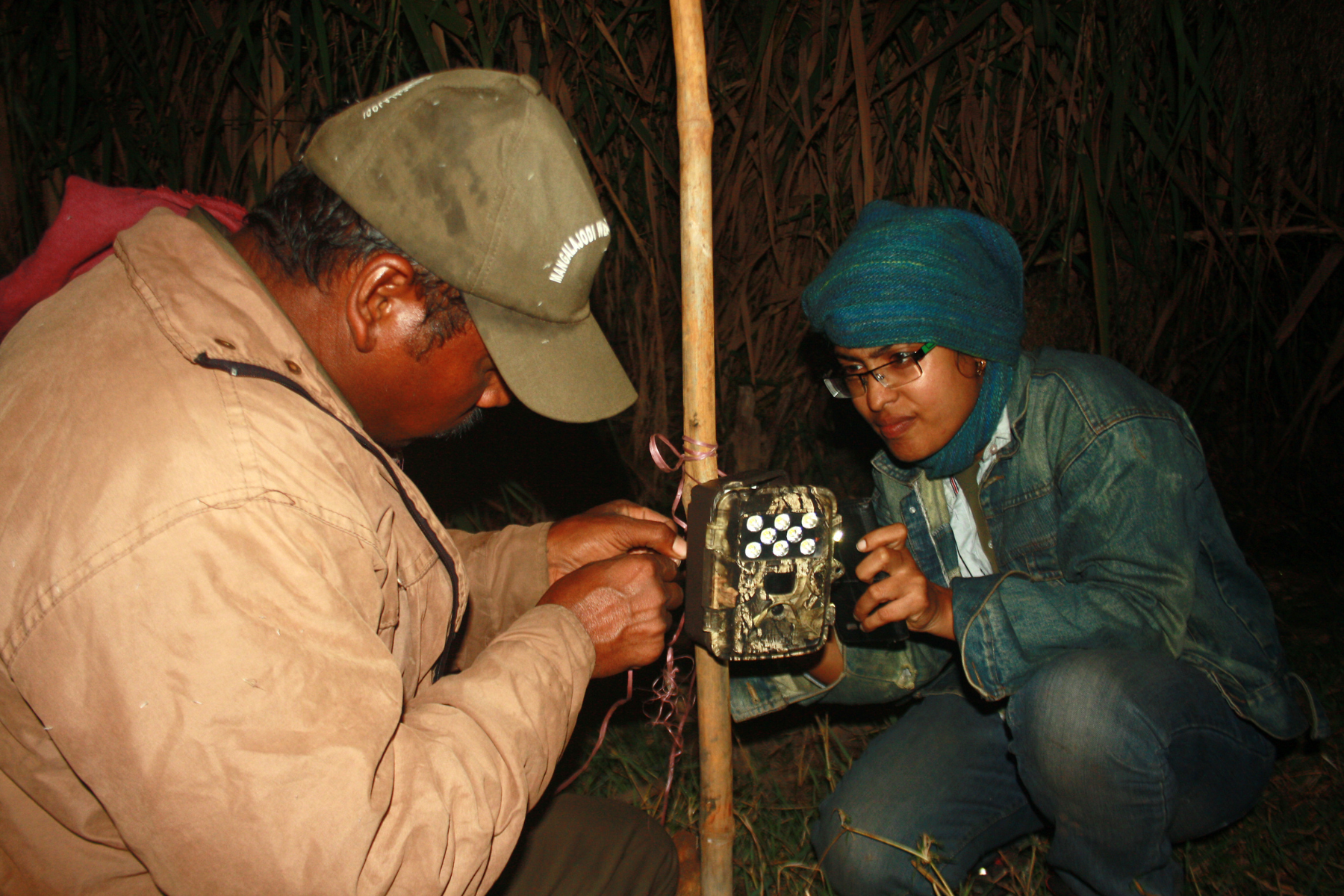 Tiasa Adhya supervising a camera trap being set up along the Chilika lagoon. The involvement and support of local fishermen and villagers has been key in population estimation studies of the fishing cat. Photo: Partha Dey.
Tiasa Adhya supervising a camera trap being set up along the Chilika lagoon. The involvement and support of local fishermen and villagers has been key in population estimation studies of the fishing cat. Photo: Partha Dey.
350
After months of relentless efforts, our perseverance finally paid off. We manually sifted through thousands of photographs and successfully identified over 350 individual fishing cats. This is a significant finding. The entire Ganga-Brahmaputra floodplains and delta region always suited fishing cats to perfection. It has served as their sanctuary throughout countless geological eras – shielding them from scorching heat and freezing cold, from relentless floods to devastating droughts. In current times, the Sundarban mangrove forests represent a subsection within this vast wet landscape, enjoying some level of protection. But out yonder, things are drastically different. The face of this onceteeming wet realm necklaced with winding creeks, intricate channels and beaded with abundant wetlands, is undergoing an unprecedented transformation. It is being turned into concrete and bound into limited, confined spaces. Yet, scattered populations of fishing cats tenaciously hold on. Amidst it all, the Sundarban remains a fortress, where the spirit of this incredible species still burns bright, providing glimmers of hope and resilience to the fragmented populations beyond. For the fishing cat and the Sundarban to thrive, we know, the flow of freshwater must remain unimpeded, cascading into the swamps with unrestrained freedom. It calls for collective global action to confront the challenges of climate change and rising sealevels, head-on.
Wetlands as Climate Security
The term ‘wetlands’ encompasses a vast array of habitat types where the land is either covered or saturated with water, including marshes, bogs, fens, and swamps; both natural and man-made; freshwater, brackish or saline. Wetlands perform numerous ecosystem services, particularly absorption and filtering of water, and act as nurseries to diverse marine and freshwater life. These wetlands act like huge sponges, absorbing water and reducing flooding. This also helps recharge groundwater aquifers. Wetlands such as mangrove forests also act as buffers against natural disasters such as cyclones, reducing coastal erosion and minimising the damage done. In light of climate change, increased natural disasters, and unpredictable rainfall patterns leading to increased flooding, the role of wetlands in tempering these effects and ensuring water security is even more crucial.
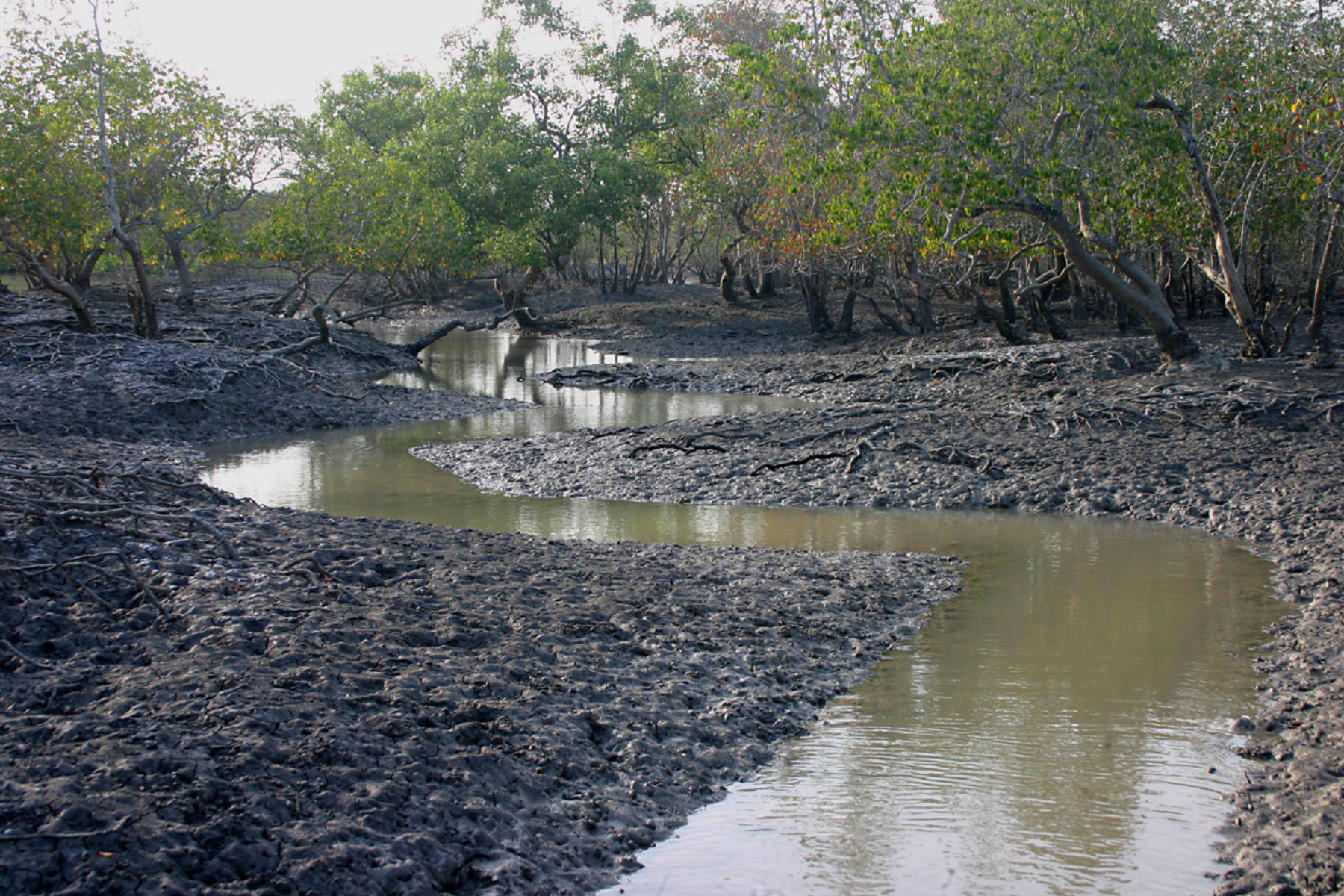 The mangrove forests of the Sundarban landscape help mitigate climate change, storing massive amounts of greenhouse gases in their roots and soils. However, they are threatened by rising sea levels as a result of human-caused climate change in addition to being cleared for aquaculture and ‘development’. Photo: Partha Dey.
The mangrove forests of the Sundarban landscape help mitigate climate change, storing massive amounts of greenhouse gases in their roots and soils. However, they are threatened by rising sea levels as a result of human-caused climate change in addition to being cleared for aquaculture and ‘development’. Photo: Partha Dey.
Cover image credit:
Project Executed by Uttar Pradesh Government in Dudhwa National Park in 2016. Team Members
- Abhilasha Yadav
- Faraz Alvi
- Shivang Mehta
- Shantanu Prasad
- Sourav Mondal
- Mridul Kantikar
Special thanks to Uttar Pradesh Forest Department, field staff of Dudhwa Tiger Reserve, Tiasa Adya for her research guidance and Prof. Amita Kanaujia, University of Lucknow.
Tiasa Adhya, co-founder of The Fishing Cat Project (the world’s longest running research and conservation project on the fishing cat), partner to Fishing Cat Conservation Alliance, a global cohort of fishing cat experts working across eight range countries and Justin Jones, Indian Forest Service Officer, Government of India, write on the experience of orchestrating the first-ever fishing cat population estimation in the state. Much to their delight, in the Panthera tigris’ mangrove delta home of Sundarban, the team reported a healthy and thriving population of Prionailurus viverrinus. The duo outlines how the study became a reality and the vital need to safeguard the species’ future.

.png)







